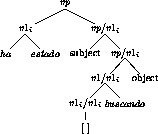


Next: Relative Clauses Up: Linguistics in MiMo2 Previous: Dutch Verb Clusters
Spanish Verb Movement
The Spanish module of MiMo2 captures the following generalizations about Spanish syntax. The first position is optionally filled by a topicalised constituent (e.g. PP, AdvP, NP). Furthermore all objects and the subject can follow the verb cluster; moreover the subject can precede (part of) the verb cluster. The examples of possible orders (modulo topicalization) are given in the following sentences:
Juan da el libro a Maria
(Juan gives the book to Maria)
Juan da a Maria el libro
Da Juan a Maria el libro
Da Juan el libro a Maria
Da el libro Juan a Maria
Da el libro a Maria Juan
Da a Maria el libro Juan
Da a Maria Juan el libro
To get the SV order as well as the VS order, we use the following two rules to place the subject in the right position:

Objects are selected with the following rule:

where the SUBCAT principle applies in the standard way. Free order among subcategorised complements is a problem that can be solved lexically or by morphological rules. Topicalization is handled by gap-threading (as described for relative clauses in the next subsection).
As it stands the rules do not yet deal with the possibility for part of the verb cluster to precede the subject, while the other part follows it:
 María
María  petroleo
petroleo
(Has been Maria searching oil)
This verb cluster can include the negation marker and other types of clitics and a possible perfective auxiliary (haber) before the progressive auxiliary `estar'. The auxiliaries `ser' (to be) and `haber' (to have) can not immediately precede the subject.
Verb clusters are built with the following rules:

To get the order where the subject is preceded by part of a verb cluster (a V1 consituent) we use a threading analysis:

This analysis facilitates a compositional semantics of the verb cluster. Note that this analysis handles cases where clitics are part of the V1:
 Juan equivocando
Juan equivocando
(Not himself has been Juan mistaking)
A simplified derivation tree of a sentence with two auxiliaries is shown in Figure 3.

Figure 3: Spanish Verb Movement
At the moment we are looking whether we can extend the verb threading analysis to verbs like modals and other aspectuals, which according to [47] have the same distribution as `estar'.
In Dutch root sentences a similar construction exists, known as `Verb Second'. Although this verb `movement' is somewhat different from Spanish (it is not lexically restricted, it can be over more constituents, and is restricted to finite verbs), the implementation is very similar to the Spanish threading analysis as described here.



Next: Relative Clauses Up: Linguistics in MiMo2 Previous: Dutch Verb Clusters
Gertjan van Noord
Thu Nov 24 19:09:23 MET 1994